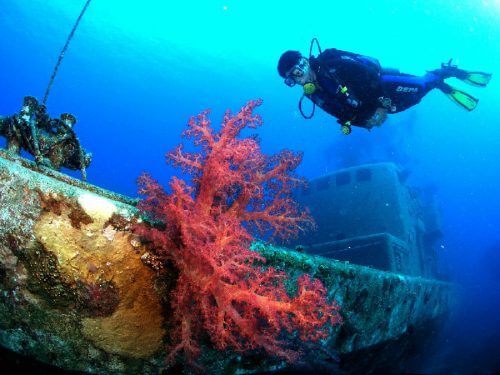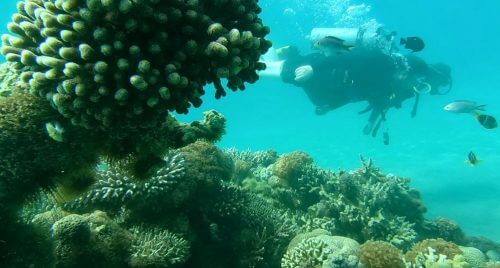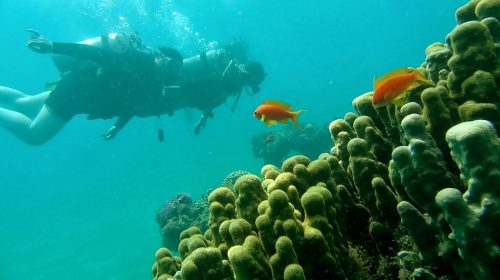What is the condition of thereef The northernmost in the world, located in Eilat? How many degrees does the sea temperature rise every year? The Ministry of Environmental Protection publishes the national monitoring report of the Gulf of Eilat for 2018

The coral reef in Eilat is the northernmost in the world. In the last 20 years, the condition of the coral reefs in the world is getting worse, and a massive mortality of corals is observed as a result of the warming of the sea water. Because of this, functioning coral reefs like the one found in Eilat are now becoming a rare natural treasure. The State of Israel recognizes the importance of the coral reef at the local and global level and, through the Ministry of Environmental Protection, has since 2004 managed a national monitoring program for the Red Sea in general and the condition of the reef, in particular. The monitoring is an important scientific tool for decisions concerning the protection of the marine environment in Eilat.
The monitoring is carried out by the Inter-University Institute for Marine Sciences in Eilat, funded by the Marine Pollution Prevention Fund of the Ministry of Environmental Protection and guided and accompanied by an administrative scientific committee. The Ministry of Environmental Protection published last night (Tuesday) the national monitoring report in the Gulf of Eilat for 2018, written by Dr. Yonatan Shaked and Prof. Ametsia Ganin from the Inter-University Institute of Marine Sciences in Eilat.
In 2018, the national monitoring was expanded - both budgetary and in terms of the monitored parameters - in order to collect the background data that will be required in the future for the purpose of characterizing the impact of large projects planned to be built in the Gulf, such as the Sea Canal project shared by the governments of Jordan and Israel (we wrote a lot about its negative effects on the Hidan website - Avi Blizovsky and Dr. Assaf Rosenthal).
In addition, the 2018 monitoring is the first to be carried out after the opening of Katsa beach to the general public. In July 2017, a stretch of beach that was previously restricted by the Katza company was opened to the public. The area opened for public use is the northern part of Katsa Beach, an area restricted to swimming by buoyed ropes. The reef sites where the monitoring program conducts its surveys are located outside the areas marked as open for swimming, but it can be expected that the number of divers passing through them will increase due to the opening of the beach. The reef surveys at the Katsa sites (at a depth of 10 and 20 meters) were done until this year (2018) before the beach was opened to the public, and this year, for the first time, these sites have been surveyed since the beach was opened to the public. At this stage, no clear negative trend was measured at the tested site as part of the national monitoring, and the issue should continue to be monitored.
According to Dr. Arena Metzner, Director of the Senior Department of Science and Research at the Ministry of Environmental Protection and Rani Amir, Director of the National Unit for the Protection of the Marine Environment at the Ministry, the condition of the coral reef in Eilat is stable - mainly due to the actions of the Ministry of Environmental Protection and the Nature Reserves and Parks Authority, which manage the various causes of pollution, including Reduction of pollution loads discharged into the sea from factories and unusual sea pollution events. - but the planned accelerated development in the bay must be carefully examined. "The preservation of the coral reef in Eilat must be put at the top of the list of priorities in any decision to promote development in the Gulf of Eilat, in order to preserve it for future generations, especially in a world where functioning coral reefs become a rare natural treasure," say Matzner and Amir.

The findings of the past year - the coral reef
1. Coverage and density of Ibn Haim corals - between the surveyed sites there are large differences in the degree of coral coverage, largely related to the nature of the soil at each site. The average coral cover in all sites was 24% this year, lower than the average value of the previous year (25.3%). The average colony density was also relatively low this year, 28.2 colonies in a ten-meter section, compared to 30.2 the previous year. The average density of coral colonies between all sites was found to increase between 2010-2017, although the changes between the years are small.
Overall, during the monitoring period, a significant increase was found in the average percentage of coverage at the monitoring sites, but it seems that in recent years this trend has weakened and this year a slight decrease was found.
2. Stone coral colony size - between the monitored reef sites there are differences in the typical coral colony size. The laboratory site has the largest proportion of small colonies, while the shallow reserve site has the smallest proportion and large and giant colonies are more common there than in other sites. In the years 2008-2012, a decrease was found in the amount of small corals in the Eilat reefs, but since then until this year there has been an increase in the density of the colonies, including also in the amount of small colonies. This year, a decrease in colony density was measured and a significant increase was found only in the number of medium-sized colonies. Large colonies are what allow it to cover the coral.
3. The index of living tissue in stone corals - since 2012, a small but continuous decrease in the percentage of living tissue of Eilat corals has been measured and the value of this index has been decreasing since the beginning of monitoring. It is possible that the decrease in the average percentage of living tissue is due, at least partially, to an improvement in survival and therefore the "maturing" of colonies that accumulate injuries and tissue damage over time.
4. Diversity of coral species - the Shannon-Wiener diversity index - in which the diversity of stony corals in the reefs of Eilat is estimated shows slight fluctuations and no trends between the years. For the most part, the diversity value in shallow sites is low compared to deep sites. The aggregation curves of coral types paint a similar picture, as does the range of the number of coral types expected by counting fifteen hundred random colonies. In all indices the changes between the years are small.
5. The reef table - the reef table is treated separately from the reef front sites, due to its unique characteristics. This year no change was found in the coral cover on the reef table and their density increased slightly, after several years in which a slight decrease was measured. The reef table is more sensitive to external disturbances than the reef front sites, and the diversity and richness of coral types is lower there. In the reef table, lumpy corals are dominant while in the reef front sites, branching corals are the main part.
6. The lagoon of the coral reserve - because in the lagoon the environmental conditions are difficult, the coral society is dominated by dominant species and the variety is small compared to the reef sites. The most common coral in the lagoon is Stylophora pistillata which makes up about 40% of all colonies. Between the summer of 2009 and the summer of 2010, there was a large decrease in the density of the coral colonies in the lagoon, and especially in the density of the dominant coral, as a result of a series of strong storms. In recent years, a recovery has been measured, although this year a decrease was found and the coral density is still low compared to the first years of monitoring.
7. Coral colonization on the reef - the monitoring program began in 2015 to monitor coral colonization at the reserve site and at the laboratory site using colonization plates, but the monitoring protocol changed over the years in order to improve its effectiveness based on collected data. In all the years it was found that at the reserve site the number of recruits is greater and they grow better than at the laboratory site. The settlement pattern at the reserve site is continuous throughout the season and at the laboratory site the pattern is less clear and the largest amount of settlers was actually found on plates that stayed in the sea until the end of September, after which we found a decrease in both number and size.
8. Sea urchins - the most important group of herders on the reef among the invertebrates is the sea urchins, of which the most common species is Diadema setosum. The density of the sea urchin D. setosum varies greatly between years and also dictates the fluctuations in the size of the urchin population in general. The density of D. setosum and the density of sea urchins in general is lower this year than in the last two years, except at the lagoon site where a slight increase was found. The density of the hedgehog Echinometra mataei has been increasing in recent years.

Perennial fluctuations and trends of change in the coral reef
1. Stony coral cover - the percentage of live stone coral coverage is the main index that reflects the condition of the coral reef over time. Between the years and between the monitored sites there are differences in the degree of coverage.
2. In the first years of monitoring (2004-6), the average coral cover in the Eilat reefs was 19-20%. In the years 2007-12 the average coverage increased and ranged from 21.5-23.9%. In 2013, the maximum coverage during the monitoring period was measured, 26.4%, in recent years the average coverage has ranged between 24.0-25.3%. The changes in the percentage of cover are not monotonous and are not the same at all sites, but throughout the monitoring period there is a distinct trend of an increase in the average percentage of cover of stony corals on the surveyed Eilat reefs, although this trend seems to be weakening in recent years and this year there was a decrease.
3. Density and size of stony coral colonies - the average density of coral colonies among all sites has also been on a continuous rise since 2010, and is higher than it was in the first years of monitoring, although the changes from year to year are small and this year there was a slight decrease. Over the years there has also been an increase in the proportion of medium and large coral colonies, indicating a higher survival rate than in the first years of monitoring.
4. The living tissue index in stony corals - this index has been on the decline since 2012. However, the changes in this index are small. It is possible that the decrease in the value of the index reflects the increasing trend in the survival and growth of colonies, which are exposed over time to cumulative damage to the coral tissue.
5. The diversity of species - the diversity of species, as well as the composition of the coral community and the range of diversity at the monitoring sites change but little from year to year, evidence of a stable community composition.
6. Among the creatures of the reef that are not corals, some that were not known in Eilat have been discovered in recent years (such as Nachshonk and Yellow Spotted Gull which were identified by the surveyors of the program) and species of fish that were rare are being observed more often. There is also an increase in the number of sea urchins that do not belong to the dominant species D. setosum.
On the same topic on the science website:
